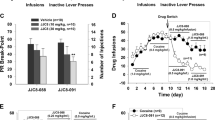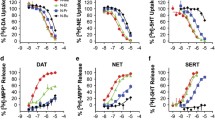Abstract
Despite increased methamphetamine use worldwide, pharmacotherapies are not available to treat methamphetamine use disorder. The vesicular monoamine transporter-2 (VMAT2) is an important pharmacological target for discovery of treatments for methamphetamine use disorder. VMAT2 inhibition by the natural product, lobeline, reduced methamphetamine-evoked dopamine release, methamphetamine-induced hyperlocomotion, and methamphetamine self-administration in rats. Compared to lobeline, lobelane exhibited improved affinity and selectivity for VMAT2 over nicotinic acetylcholine receptors. Lobelane inhibited neurochemical and behavioral effects of methamphetamine, but tolerance developed to its behavioral efficacy in reducing methamphetamine self-administration, preventing further development. The lobelane analog, R-N-(1,2-dihydroxypropyl)-2,6-cis-di-(4-methoxyphenethyl)piperidine hydrochloride (GZ-793A), potently and selectively inhibited VMAT2 function and reduced neurochemical and behavioral effects of methamphetamine. However, GZ-793A exhibited potential to induce ventricular arrhythmias interacting with human-ether-a-go-go (hERG) channels. Herein, a new lead, R-3-(4-methoxyphenyl)-N-(1-phenylpropan-2-yl)propan-1-amine (GZ-11610), from the novel scaffold (N-alkyl(1-methyl-2-phenylethyl)amine) was evaluated as a VMAT2 inhibitor and potential therapeutic for methamphetamine use disorder. GZ-11610 was 290-fold selective for VMAT2 over dopamine transporters, suggesting that it may lack abuse liability. GZ-11610 was 640- to 3500-fold selective for VMAT2 over serotonin transporters and nicotinic acetylcholine receptors. GZ-11610 exhibited > 1000-fold selectivity for VMAT2 over hERG, representing a robust improvement relative to our previous VMAT2 inhibitors. GZ-11610 (3–30 mg/kg, s.c. or 56-300 mg/kg, oral) reduced methamphetamine-induced hyperactivity in methamphetamine-sensitized rats. Thus, GZ-11610 is a potent and selective inhibitor of VMAT2, may have low abuse liability and low cardiotoxicity, and after oral administration is effective and specific in inhibiting the locomotor stimulant effects of methamphetamine, suggesting further investigation as a potential therapeutic for methamphetamine use disorder.





Similar content being viewed by others
REFERENCES
World Drug Report from the United Nations Office on Drugs and Crime (UNODC) [Internet]. Available from: http://www.unodc.org/.
Wise RA, Rompre PP. Brain dopamine and reward. Annu Rev Psychol. 1989;40(1):191–225. https://doi.org/10.1146/annurev.ps.40.020189.001203.
Di Chiara G, Imperato A. Drugs abused by humans preferentially increase synaptic dopamine concentrations in the mesolimbic system of freely moving rats. Proc Natl Acad Sci U A. 1988;85(14):5274–8. https://doi.org/10.1073/pnas.85.14.5274.
Gulaboski R, Cordeiro MNDS, Milhazes N, Garrido J, Borges F, Jorge M, et al. Evaluation of the lipophilic properties of opioids, amphetamine-like drugs, and metabolites through electrochemical studies at the interface between two immiscible solutions. Anal Biochem. 2007;361(2):236–43. https://doi.org/10.1016/j.ab.2006.11.006.
Johnson RA, Eshleman AJ, Meyers T, Neve KA, Janowsky A. [3H]substrate- and cell-specific effects of uptake inhibitors on human dopamine and serotonin transporter-mediated efflux. Synap N Y N. 1998;30(1):97–106. https://doi.org/10.1002/(SICI)1098-2396(199809)30:1<97::AID-SYN12>3.0.CO;2-M.
Mantle TJ, Tipton KF, Garrett NJ. Inhibition of monoamine oxidase by amphetamine and related compounds. Biochem Pharmacol. 1976;25(18):2073–7. https://doi.org/10.1016/0006-2952(76)90432-9.
Peter D, Jimenez J, Liu Y, Kim J, Edwards RH. The chromaffin granule and synaptic vesicle amine transporters differ in substrate recognition and sensitivity to inhibitors. J Biol Chem. 1994;269(10):7231–7.
Sulzer D, Sonders MS, Poulsen NW, Galli A. Mechanisms of neurotransmitter release by amphetamines: a review. Prog Neurobiol. 2005;75(6):406–33. https://doi.org/10.1016/j.pneurobio.2005.04.003.
Horton DB, Nickell JR, Zheng G, Crooks PA, Dwoskin LP. GZ-793A, a lobelane analog, interacts with the vesicular monoamine transporter-2 to inhibit the effect of methamphetamine. J Neurochem. 2013;127(2):177–86. https://doi.org/10.1111/jnc.12371.
Schuldiner S, Steiner-Mordoch S, Yelin R, Wall SC, Rudnick G. Amphetamine derivatives interact with both plasma membrane and secretory vesicle biogenic amine transporters. Mol Pharmacol. 1993;44(6):1227–31.
Sulzer D, Rayport S. Amphetamine and other psychostimulants reduce pH gradients in midbrain dopaminergic neurons and chromaffin granules: a mechanism of action. Neuron. 1990;5(6):797–808. https://doi.org/10.1016/0896-6273(90)90339-H.
Sulzer D, Chen TK, Lau YY, Kristensen H, Rayport S, Ewing A. Amphetamine redistributes dopamine from synaptic vesicles to the cytosol and promotes reverse transport. J Neurosci. 1995;15(5 Pt 2):4102–8.
Fleckenstein AE, Volz TJ, Riddle EL, Gibb JW, Hanson GR. New insights into the mechanism of action of amphetamines. Annu Rev Pharmacol Toxicol. 2007;47(1):681–98. https://doi.org/10.1146/annurev.pharmtox.47.120505.105140.
Volkow ND, Wang G-J, Fowler JS, Tomasi D, Telang F. Addiction: beyond dopamine reward circuitry. Proc Natl Acad Sci U S A. 2011;108(37):15037–42. https://doi.org/10.1073/pnas.1010654108.
Lyness WH, Friedle NM, Moore KE. Destruction of dopaminergic nerve terminals in nucleus accumbens: effect on d-amphetamine self-administration. Pharmacol Biochem Behav. 1979;11(5):553–6. https://doi.org/10.1016/0091-3057(79)90040-6.
Dwoskin LP, Crooks PA. A novel mechanism of action and potential use for lobeline as a treatment for psychostimulant abuse. Biochem Pharmacol. 2002;63(2):89–98. https://doi.org/10.1016/S0006-2952(01)00899-1.
Teng L, Crooks PA, Sonsalla PK, Dwoskin LP. Lobeline and nicotine evoke [3H]overflow from rat striatal slices preloaded with [3H]dopamine: differential inhibition of synaptosomal and vesicular [3H]dopamine uptake. J Pharmacol Exp Ther. 1997;280(3):1432–44.
Wilhelm CJ, Johnson RA, Lysko PG, Eshleman AJ, Janowsky A. Effects of methamphetamine and lobeline on vesicular monoamine and dopamine transporter-mediated dopamine release in a cotransfected model system. J Pharmacol Exp Ther. 2004;310(3):1142–51. https://doi.org/10.1124/jpet.104.067314.
Wilhelm CJ, Johnson RA, Eshleman AJ, Janowsky A. Lobeline effects on tonic and methamphetamine-induced dopamine release. Biochem Pharmacol. 2008;75(6):1411–5. https://doi.org/10.1016/j.bcp.2007.11.019.
Nickell JR, Krishnamurthy S, Norrholm S, Deaciuc G, Siripurapu KB, Zheng G, et al. Lobelane inhibits methamphetamine-evoked dopamine release via inhibition of the vesicular monoamine transporter-2. J Pharmacol Exp Ther. 2010;332(2):612–21. https://doi.org/10.1124/jpet.109.160275.
Miller DK, Crooks PA, Teng L, Witkin JM, Munzar P, Goldberg SR, et al. Lobeline inhibits the neurochemical and behavioral effects of amphetamine. J Pharmacol Exp Ther. 2001;296(3):1023–34.
Harrod SB, Dwoskin LP, Crooks PA, Klebaur JE, Bardo MT. Lobeline attenuates d-methamphetamine self-administration in rats. J Pharmacol Exp Ther. 2001;298(1):172–9.
Harrod SB, Dwoskin LP, Green TA, Gehrke BJ, Bardo MT. Lobeline does not serve as a reinforcer in rats. Psychopharmacology. 2003;165(4):397–404. https://doi.org/10.1007/s00213-002-1289-6.
Teng L, Crooks PA, Dwoskin LP. Lobeline displaces [3H]dihydrotetrabenazine binding and releases [3H]dopamine from rat striatal synaptic vesicles: comparison with d-amphetamine. J Neurochem. 1998;71(1):258–65.
Zheng G, Dwoskin LP, Deaciuc AG, Norrholm SD, Crooks PA. Defunctionalized lobeline analogues: structure-activity of novel ligands for the vesicular monoamine transporter. J Med Chem. 2005;48(17):5551–60. https://doi.org/10.1021/jm0501228.
Nickell JR, Siripurapu KB, Vartak A, Crooks PA, Dwoskin LP, Torres B, et al. The vesicular monoamine transporter-2: an important pharmacological target for the discovery of novel therapeutics to treat methamphetamine abuse. Adv Pharmacol. 2014;69(21):71–106.
Miller DK, Lever JR, Rodvelt KR, Baskett JA, Will MJ, Kracke GR. Lobeline, a potential pharmacotherapy for drug addiction, binds to mu opioid receptors and diminishes the effects of opioid receptor agonists. Drug Alcohol Depend. 2007;89(2–3):282–91. https://doi.org/10.1016/j.drugalcdep.2007.02.003.
Harrod SB, Dwoskin LP, Bardo MT. Lobeline produces conditioned taste avoidance in rats. Pharmacol Biochem Behav. 2004;78(1):1–5. https://doi.org/10.1016/j.pbb.2004.01.011.
Glover ED, Rath JM, Sharma E, Glover PN, Laflin M, Tonnesen P, et al. Amulticenter phase 3 trial of lobeline sulfate for smoking cessation. Am J Health Behav. 2010;34(1):101–9.
Miller DK, Harrod SB, Green TA, Wong M-Y, Bardo MT, Dwoskin LP. Lobeline attenuates locomotor stimulation induced by repeated nicotine administration in rats. Pharmacol Biochem Behav. 2003;74(2):279–86. https://doi.org/10.1016/S0091-3057(02)00996-6.
Miller DK, Crooks PA, Zheng G, Grinevich VP, Norrholm SD, Dwoskin LP. Lobeline analogs with enhanced affinity and selectivity for plasmalemma and vesicular monoamine transporters. J Pharmacol Exp Ther. 2004;310(3):1035–45. https://doi.org/10.1124/jpet.104.068098.
Neugebauer NM, Harrod SB, Stairs DJ, Crooks PA, Dwoskin LP, Bardo MT. Lobelane decreases methamphetamine self-administration in rats. Eur J Pharmacol. 2007;571(1):33–8. https://doi.org/10.1016/j.ejphar.2007.06.003.
Nickell JR, Siripurapu KB, Horton DB, Zheng G, Crooks PA, Dwoskin LP. GZ-793A inhibits the neurochemical effects of methamphetamine via a selective interaction with the vesicular monoamine transporter-2. Eur J Pharmacol. 2017;795:143–9. https://doi.org/10.1016/j.ejphar.2016.12.016.
Meyer AC, Neugebauer NM, Zheng G, Crooks PA, Dwoskin LP, Bardo MT. Effects of VMAT2 inhibitors lobeline and GZ-793A on methamphetamine-induced changes in dopamine release, metabolism and synthesis in vivo. J Neurochem. 2013;127(2):187–98. https://doi.org/10.1111/jnc.12373.
Beckmann JS, Denehy ED, Zheng G, Crooks PA, Dwoskin LP, Bardo MT. The effect of a novel VMAT2 inhibitor, GZ-793A, on methamphetamine reward in rats. Psychopharmacol Berl. 2012;220(2):395–403. https://doi.org/10.1007/s00213-011-2488-9.
Alvers KM, Beckmann JS, Zheng G, Crooks PA, Dwoskin LP, Bardo MT. The effect of VMAT2 inhibitor GZ-793A on the reinstatement of methamphetamine-seeking in rats. Psychopharmacol Berl. 2012;224(2):255–62. https://doi.org/10.1007/s00213-012-2748-3.
Wilmouth CE, Zheng G, Crooks PA, Dwoskin LP, Bardo MT. Oral administration of GZ-793A, a VMAT2 inhibitor, decreases methamphetamine self-administration in rats. Pharmacol Biochem Behav. 2013;112:29–33. https://doi.org/10.1016/j.pbb.2013.09.006.
Norrholm SD, Horton DB, Dwoskin LP. The promiscuity of the dopamine transporter: implications for the kinetic analysis of [3H]serotonin uptake in rat hippocampal and striatal synaptosomes. Neuropharmacology. 2007;53(8):982–9. https://doi.org/10.1016/j.neuropharm.2007.10.001.
Horton DB, Siripurapu KB, Norrholm SD, Culver JP, Hojahmat M, Beckmann JS, et al. Meso-Transdiene analogs inhibit vesicular monoamine transporter-2 function and methamphetamine-evoked dopamine release. J Pharmacol Exp Ther. 2011;336(3):940–51. https://doi.org/10.1124/jpet.110.175117.
Sviripa VM, Zhang W, Balia AG, Tsodikov OV, Nickell JR, Gizard F, et al. 2′,6′-Dihalostyrylanilines, pyridines, and pyrimidines for the inhibition of the catalytic subunit of methionine S-adenosyltransferase-2. J Med Chem. 2014;57(14):6083–91. https://doi.org/10.1021/jm5004864.
Teschemacher AG, Seward EP, Hancox JC, Witchel HJ. Inhibition of the current of heterologously expressed HERG potassium channels by imipramine and amitriptyline. Br J Pharmacol. 1999;128(2):479–85. https://doi.org/10.1038/sj.bjp.0702800.
Jo SH, Youm JB, Lee CO, Earm YE, Ho WK. Blockade of the HERG human cardiac K(+) channel by the antidepressant drug amitriptyline. Br J Pharmacol. 2000;129(7):1474–80. https://doi.org/10.1038/sj.bjp.0703222.
Cheng Y, Prusoff WH. Relationship between the inhibition constant (K1) and the concentration of inhibitor which causes 50 per cent inhibition (I50) of an enzymatic reaction. Biochem Pharmacol. 1973;22(23):3099–108.
Heal DJ, Smith SL, Gosden J, Nutt DJ. Amphetamine, past and present—a pharmacological and clinical perspective. J Psychopharmacol Oxf Engl. 2013;27(6):479–96. https://doi.org/10.1177/0269881113482532.
Stathis M, Scheffel U, Lever SZ, Boja JW, Carroll FI, Kuhar MJ. Rate of binding of various inhibitors at the dopamine transporter in vivo. Psychopharmacology. 1995;119(4):376–84. https://doi.org/10.1007/BF02245852.
Swanson JM, Volkow ND. Serum and brain concentrations of methylphenidate: implications for use and abuse. Neurosci Biobehav Rev. 2003;27(7):615–21. https://doi.org/10.1016/j.neubiorev.2003.08.013.
Volkow ND, Swanson JM. Variables that affect the clinical use and abuse of methylphenidate in the treatment of ADHD. Am J Psychiatry. 2003;160(11):1909–18. https://doi.org/10.1176/appi.ajp.160.11.1909.
German CL, Baladi MG, McFadden LM, Hanson GR, Fleckenstein AE. Regulation of the dopamine and vesicular monoamine transporters: pharmacological targets and implications for disease. Pharmacol Rev. 2015;67(4):1005–24. https://doi.org/10.1124/pr.114.010397.
Trudeau MC, Warmke JW, Ganetzky B, Robertson GA. HERG, a human inward rectifier in the voltage-gated potassium channel family. Science. 1995;269(5220):92–5. https://doi.org/10.1126/science.7604285.
Abbott GW, Sesti F, Splawski I, Buck ME, Lehmann MH, Timothy KW, et al. MiRP1 forms IKr potassium channels with HERG and is associated with cardiac arrhythmia. Cell. 1999;97(2):175–87. https://doi.org/10.1016/S0092-8674(00)80728-X.
Doggrell SA, Hancox JC. Cardiac safety concerns for domperidone, an antiemetic and prokinetic, and galactogogue medicine. Expert Opin Drug Saf. 2014;13(1):131–8. https://doi.org/10.1517/14740338.2014.851193.
Vezina P, Lorrain DS, Arnold GM, Austin JD, Suto N. Sensitization of midbrain dopamine neuron reactivity promotes the pursuit of amphetamine. J Neurosci. 2002;22(11):4654–62.
Wang Q, Li D, Bubula N, Campioni MR, McGehee DS, Vezina P. Sensitizing exposure to amphetamine increases AMPA receptor phosphorylation without increasing cell surface expression in the rat nucleus accumbens. Neuropharmacology. 2017;117:328–37. https://doi.org/10.1016/j.neuropharm.2017.02.018.
Kalivas PW, Stewart J. Dopamine transmission in the initiation and expression of drug- and stress-induced sensitization of motor activity. Brain Res Brain Res Rev. 1991;16(3):223–44. https://doi.org/10.1016/0165-0173(91)90007-U.
Funding
This work was supported by funding from the National Institute of Health grants U01 DA013519 and UL1 TR001998.
Author information
Authors and Affiliations
Corresponding author
Additional information
Guest Editors: Shraddha Thakkar and Cesar M. Compadre
Rights and permissions
About this article
Cite this article
Lee, NR., Zheng, G., Crooks, P.A. et al. New Scaffold for Lead Compounds to Treat Methamphetamine Use Disorders. AAPS J 20, 29 (2018). https://doi.org/10.1208/s12248-018-0192-y
Received:
Accepted:
Published:
DOI: https://doi.org/10.1208/s12248-018-0192-y




